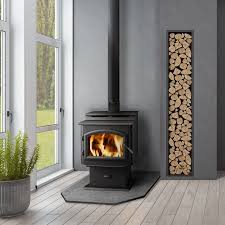Wood stoves have been essential in homes for centuries, providing warmth, a place to cook, and a comforting glow. Over the years, they’ve transformed from rudimentary heating devices to sophisticated, efficient appliances. In this blog, we’ll take a journey through the fascinating history of wood stoves, exploring their evolution from early forms to modern innovations.
The Origins of Wood Stoves: Early Beginnings
Before wood stoves existed, people relied on open fires to stay warm. These fires were often contained within fireplaces made of stone or brick, but they were far from efficient. The earliest known use of a contained fire for heating dates back to ancient times, where fires were built in simple hearths within homes. While effective for warmth, open fireplaces allowed most of the heat to escape up the chimney, wasting valuable fuel.
The demand for better heating efficiency in colder regions of Europe and North America spurred the development of the first enclosed wood-burning stoves. By containing the fire within a metal or brick structure, these stoves retained more heat, directing it into the room rather than allowing it to escape.
The First Wood Stoves: 16th and 17th Century Innovations
The first recorded wood stove design emerged in Europe in the early 1500s, crafted from materials like iron and brick. One notable early innovation was the Cast Iron Stove, developed in Germany in the 17th century. These stoves offered significantly better heat retention than fireplaces, and their enclosed design allowed for a slower, more controlled burn. They also required less wood, making them a more efficient choice.
As wood stoves became more popular, they started to appear in North America, where winters could be harsh and long. The practicality and efficiency of wood stoves made them essential for early settlers, especially in areas without access to alternative heating sources.
The Franklin Stove: A Revolutionary Design
In the 18th century, one of the most iconic wood stoves was born: the Franklin Stove. Designed by Benjamin Franklin in 1742, this cast iron stove was revolutionary for its time. Franklin’s stove featured a two-plate design that improved air circulation, allowing the stove to heat a room more evenly and with less fuel.
The Franklin Stove introduced the idea of venting smoke outside through a flue or chimney, which helped reduce indoor smoke and increased safety. While Franklin’s stove had some drawbacks, it influenced future stove designs, marking a turning point in the history of wood-burning technology.
Industrial Revolution: Mass Production and Improved Designs
The 19th century brought major advancements to wood stove technology, largely due to the Industrial Revolution. With advancements in metalworking and manufacturing, wood stoves could be mass-produced, making them more affordable and accessible. New designs like the Potbelly Stove, with its iconic round shape, became popular.
Potbelly stoves were commonly used in public spaces, such as schools, railway stations, and shops. These stoves provided consistent heat and could burn for hours with minimal supervision. They were highly durable and efficient, and their compact design made them suitable for smaller spaces.
The 20th Century: From Efficiency to Aesthetics
By the 20th century, wood stoves had firmly established themselves as a staple in homes and public buildings. However, as electricity and gas became more accessible, wood stoves began to decline in popularity for a time. Many people opted for electric or gas heating, which required less effort to operate.
Despite this shift, wood stoves remained popular in rural areas and among people who valued their reliability during power outages. During this period, wood stoves evolved to become more than just heating devices; they also became a part of home decor. Manufacturers started to focus on aesthetic appeal, producing stoves with decorative elements that complemented home interiors.
Environmental Awareness and the Rise of Eco-Friendly Wood Stoves
In the latter half of the 20th century, rising environmental awareness brought a renewed interest in wood stoves. People began to recognize that burning wood, when done correctly, could be a sustainable way to heat a home. As a result, companies started to design Eco-Friendly Wood Stoves that adhered to emissions standards and prioritized efficiency.
The Environmental Protection Agency (EPA) in the United States played a significant role in this shift. In the 1980s, the EPA introduced emissions regulations for wood stoves, pushing manufacturers to reduce pollutants and improve combustion efficiency. New technologies, such as catalytic and non-catalytic combustors, were developed to meet these standards, making wood stoves cleaner and more efficient than ever.
Modern Wood Stoves: High Efficiency and Technology Integration
Today’s wood stoves are a far cry from the basic iron models of the past. Modern wood stoves are designed with advanced features that enhance both efficiency and user experience. Catalytic wood stoves, for example, use a ceramic combustor to reduce emissions and extend burn times, making them more efficient than non-catalytic models.
Non-catalytic wood stoves, on the other hand, rely on a secondary combustion system to achieve similar results without the use of a catalytic combustor. These systems allow stoves to produce less smoke, burn fuel more completely, and provide consistent heat.
Some modern wood stoves even integrate smart technology to monitor temperature, adjust air flow, and alert users when it’s time to refuel. These innovations make it easier to operate a wood stove efficiently, reducing waste and ensuring a cleaner burn.
Wood Stoves and Sustainability: A Greener Future
As we look to the future, wood stoves continue to be a valuable heating solution, especially in areas where renewable energy sources may be limited. With sustainably sourced firewood or wood pellets, wood stoves can provide carbon-neutral heat, contributing to a greener, low-emission home.
Many people now choose wood stoves as part of an eco-conscious lifestyle. By opting for high-efficiency models and following best practices for burning wood, it’s possible to enjoy the warmth of a wood stove while minimizing environmental impact.
Conclusion: A Timeless Heating Solution
The history of wood stoves is a testament to human ingenuity and the quest for comfort and efficiency. From early stone hearths to modern high-efficiency stoves, the evolution of wood-burning technology has transformed the way we heat our homes. Today, wood stoves offer a blend of tradition and innovation, combining warmth with sustainability. Whether you’re drawn to their aesthetic appeal or their eco-friendly benefits, wood stoves continue to be a valuable, enduring choice for homeowners around the world.
FAQs
1. Are modern wood stoves more efficient than older models?
Yes, modern wood stoves are designed to be highly efficient, with features that reduce emissions and maximize heat output.
2. What is the difference between catalytic and non-catalytic wood stoves?
Catalytic wood stoves use a catalytic combustor to reduce emissions and extend burn times, while non-catalytic stoves use a secondary combustion system for a similar effect.
3. Are wood stoves environmentally friendly?
When used with sustainably sourced fuel and operated properly, wood stoves can be a low-emission, eco-friendly heating option.
4. Can wood stoves be used during power outages?
Yes, wood stoves are an excellent heating solution during power outages, as they don’t require electricity to operate.
5. How long do modern wood stoves last?
With proper maintenance, modern wood stoves can last 10–20 years or more, depending on the model and usage.




